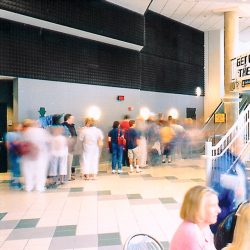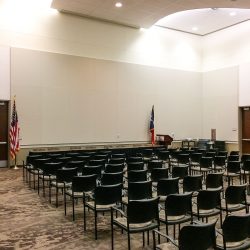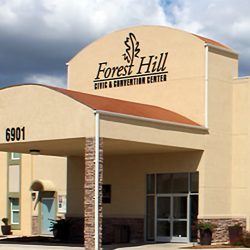Tweed - New Haven Airport
The Issue
Like virtually all airports around the world, the terminal building at Tweed-New Haven airport had a problem: Reverberation. As a result, the public address system used to page people and make flight announcements was virtually unintelligible, causing confusion and inconvenience for employees and travelers alike.
The Challenge
While problems of this type abound in public buildings, this case was especially severe and with good reason. The 229,000-cubic foot space was designed and initially used as an airplane hangar. Never intended as an acoustically friendly space, it had a number of properties that exacerbated reverberation—such as reflective glass block walls, vinyl covered concrete flooring and a steel ceiling. To make matters worse, these hard surfaces were parallel to each other, which allowed sound to bounce freely from wall to wall and ceiling to floor with minimal diffusion. According to Susan Lewis, Airport Manager, the noise problem did not go unnoticed. “I received complaints from the airlines, rental car agencies, food concessionaires and passengers”, she says. “No one could understand the announcements.”
The Solution
The first step in the acoustical treatment was to measure the amount of reverberation in the terminal. This involved conducting an RT60 test at 2:00 AM when the facility was virtually empty and at its quietest. The basic reverberation test was conducted using a hand-held decibel meter to measure the amount of time it takes for a loud noise to decay by 60 decibels. Simply popping a 20″ balloon with a pin created the sound. According to architectural acoustic design guidelines, the ideal reverberation time for speech to be totally intelligible in a room of this volume would be 1.5 seconds. However, in this case it was 5 seconds, no wonder the place echoed as badly as it did.
To solve the problem, Sonex® Sound Baffles were recommended for suspension from the ceiling. Baffles provide significantly better sound absorption than treatments that attach direct to the face of walls and ceilings. The reason is that a free hanging baffle can absorb sound on all sides, rather than on a single surface. According to the calculations, the job would have required 700 2’x4′ Sonex® Valueline Hanging Baffles to bring the reverberation level to the desired 1.5 seconds. This goal, however, proved to be unrealistic. Not only were there budget considerations, but also the ceiling space was simply not large enough to handle that quantity of hanging baffles. The reverberation target was readjusted to 2.0 seconds as an economical and practical compromise.
To reach this goal, it was determined that the space needed an octal of 3,500 sabins of sound absorption. Each 2′ x 4′ x 2″ Sonex® Sound Baffle absorbs approximately 10 sabins, so 350 baffles were recommended to be installed. The excellent sound absorption capabilities and affordability are two of the main reasons why Sonex® Valueline Hanging Baffles were a good choice for this application. Other reasons include the fact that Sonex® Valueline Hanging Baffles are made of a melamine foam material, which is a Class 1 Fire Rated building material with low flame spread and smoke production. This is always an important consideration—especially in public buildings. In addition, the subtle convolutions on the surface of the baffles make them aesthetically eye pleasing.
The Result
Upon completion of the project, a follow up reverberation test was done to determine the effectiveness of the solution. The Sonex® Sound Baffle lowered the reverberation time down to 1.8 seconds, which was a full 10% better than the design target. The true measurement of the solution’s effectiveness, however, is how well the people who work at the airport receive it. These results were equally pleasing. “Since the Sonex® Valueline Hanging Baffles were installed, there have been many positive reactions,” Lewis says. “People have commented on how nice it is to finally be able to hear the public address announcements. I’ve also heard many people say that they think the baffles enhance the look of the facility, too.”
Lewis also noted that the benefits of the Sonex® Sound Baffle extend beyond its acoustic and aesthetic values. “The airport is currently trying to attract more airlines to the facility. I believe that the improved sound environment will make the facility more customer friendly and attractive to both airlines and passengers.” Tweed-New Haven is now one of the few municipal airports in the country where you can actually understand everything that’s said on the public address system.
To learn more about how Acoustical Solutions can solve your noise control problems, use our contact form, call one of our Acoustical Sales Consultants at (800) 782-5742, or visit us on the web at acousticalsolutions.com.









